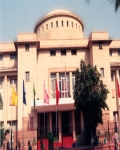- Latest Archaeology Updates
- Importance and applicability
- Famous Archaeologists
- Museums Collections
- Site Map
- World Heritage Sites
- World History Monuments
- Archaeological Organizations
- World Atlas of Archaeology
- Forensic Investigation and Geophysics
- Contact Us
- Movies based on Archaeology
- Frequently Asked Questions
- Archaeological discoveries
- Tell a Friend
- Archaeological Abbreviations
- Gallery Collections
- Famous-Museums site map
- Famous-archaeologists site map
- Archaeological Monuments site map
The National Museum is a public museum located in many countries around the world. It typically houses a collection of artifacts and exhibits related to the country’s cultural heritage, history and art. These collections often include paintings, sculptures, archaeological artefacts, coins, documents, and other materials. National museums can also be dedicated to particular themes, such as science, technology, or natural history.
The first National Museum was established in 1764, in Florence, Italy. Since then, many other countries have followed suit, with France, the United Kingdom, Germany and the United States among the first to establish their own national museums. Today, there are over 200 national museums around the world, ranging from large and comprehensive institutions to small, specialized museums. The National Museum of a country is typically its most important museum, and is often visited by millions of tourists every year. It is a major source of information about the country’s history, culture and art. It also serves as a repository for important artworks and artifacts that would otherwise be lost or destroyed. Visitors to a National Museum can typically expect to find a variety of exhibits related to the country’s culture, history and art. Exhibits may include artwork, sculptures, archaeological finds, coins, documents, and other materials. Some national museums also host special exhibitions and events, such as lectures, performances, and workshops, to further educate and engage visitors. The National Museum of a country is an important part of its cultural heritage and a symbol of its identity. It can also be a source of pride for citizens and a source of inspiration for future generations. National museums are also important for preserving the country’s history, as they often contain rare and valuable artifacts that cannot be found anywhere else in the world. As such, they are a vital part of the cultural and historical landscape of a country.

